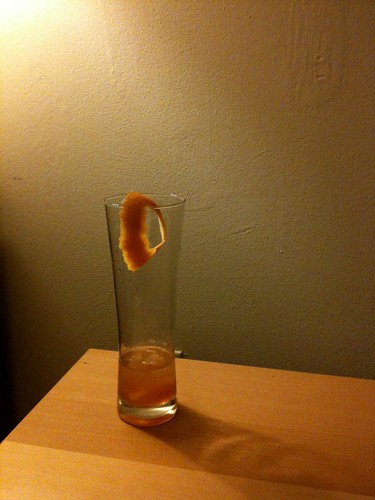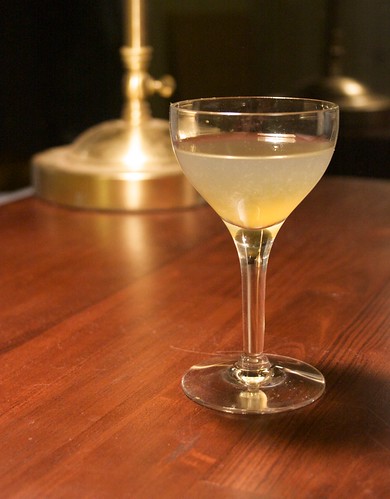There are a few things I love; here are some pertinent examples.
Good apples
Good calvados
Good fresh cider
If you mix the second two, an unsurprisingly good thing comes out of it: The cider cocktail. Also, linear algebra, but that is a story for another day. Add the first as a garnish and you've made it pretty. Rim the glass with cinnamon and sugar (sometimes called cinny in my house), serve it in Chimayo, NM, and you've got a Chimayo cocktail. Sometimes this is exactly what one wants. It happens to be one of those drinks where better ingredients = better drink. Linear algebra again, damn. So using peak-of-the-season cider and Germain-Robin apple brandy make a wonderful but horribly expensive drink. Taking this, using slightly less-good ingredients, and taking the New Mexico theme a bit further, I wound up with the following:
Chimayo II
1 oz. Laird's 7.5 year apple brandy
2 oz. Michigan apple cider
dash angostura bitters
1 teaspoon vodka infused with ginger (take vodka, chop up ginger and soak for a few weeks)
1 teaspoon vodka infused with medium hot pepper (take vodka, cut pepper into rings and soak for a few hours)
1 glass rimmed with cinny+ (couple tablespoons sugar, couple teaspoons cinnamon, fat pinch Chimayo chili powder, fat pinch table salt)
This is totally drinkable. Pretty good, even. I'm pretty happy with it. The ginger gets buried and just makes everything else shine a bit brighter. The cinny+ is pretty great, I might use it in other things. The pepper rings soaked in vodka are a great garnish, and add a crisp, wild spiciness that is quite suitable. The problem here is with gilding the lily. This is a lot of work, and the end result is but a pale shadow of any of my great loves. It's really quite poetic. What's my name? Oh yeah.
The second drink I made was even more work, and produced the most egregiously baroque lily I've ever seen. I put the recipe here only for academic purposes.
Appletini:
1.5 oz apple infused genever gin (chop up apples, soak in genever)
dash dry vermouth
dash apple brandy
dash ginger infused vodka
garnish with grape tomatoes soaked in vodka
This is drinkable, it just isn't anything good. The tomato garnish, on the other hand, is super-duper good, and I recommend making tomatoes like that and using them in everything.
You may ask, what the hell was I thinking? Well, here was the idea. I wanted something crisp and authentic to the experience of biting into a raw apple. The gin martini thing seemed ike a good starting point. What I really wanted was something to act like apple aromatic bitters would. Something to add a slash of apple smell and taste to an otherwise balanced, clean drink. The infusion, though, doesn't give this effect. The taste is muddy, and while it is possible to balance the drink overall, it doesn't really taste like anything. Interestingly, it doesn't even taste like gin, anymore. Who knows why that is.
Time to regroup, have some calvados, and stoke the competitive fires for next time.









